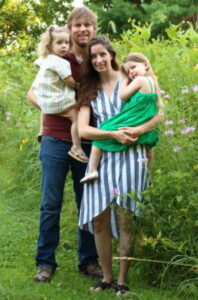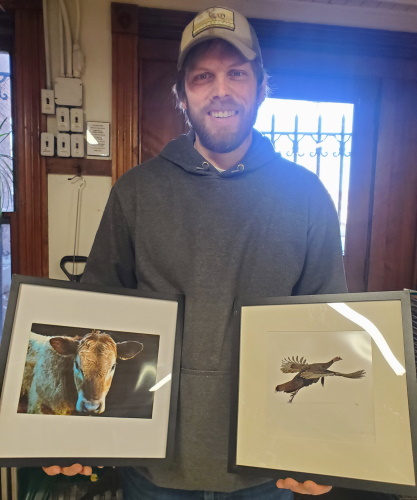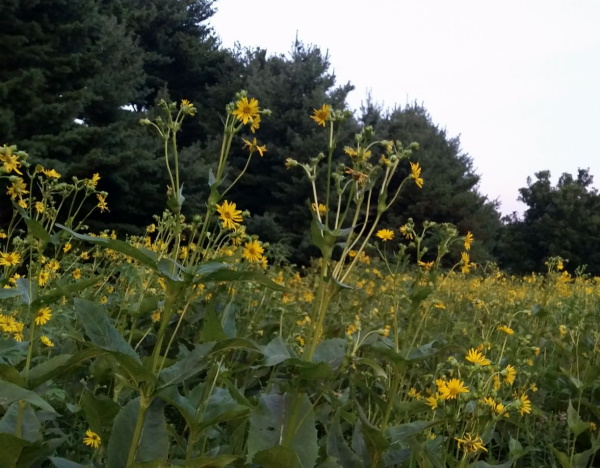 Editor’s note: Photographer Jay Dirks is restoring his bi-State properties back to their rich, native ecosystems. He is a member of Whiteside County Soil & Water Conservation Board. To complete his interview, he submitted an essay that began with a passage from History of Whiteside County, Illinois, From its First Settlement to the Present Time ©1877.
Editor’s note: Photographer Jay Dirks is restoring his bi-State properties back to their rich, native ecosystems. He is a member of Whiteside County Soil & Water Conservation Board. To complete his interview, he submitted an essay that began with a passage from History of Whiteside County, Illinois, From its First Settlement to the Present Time ©1877.
Sterling, IL, resident Jay Dirks is the sixth and newest Photographer to exhibit artful images, at The Loft on Main, 112 E. Main Street, Morrison, IL. He took this photo (using a timer) of wife Staci and daughters: Kindergartener Briar (left) and Second Grader Wren. There is a three-generation thread of Dirks photographers from Jay’s mother, Linda, to his daughters, who “do like to take photos.”
Dirks commented, “I have always experimented with taking photos. It started in Middle School with disposable cameras. In High School I borrowed my mother’s film camera and was baffled by focus, exposure, shutter speed, and the development processes.” Dirks describes himself as self-taught. Online courses added to his camera expertise.

Jay Dirks is surrounded by his favorite, compelling subject matter: the natural world. He lives among white-tailed deer, owls, turkeys, and bees. There are 100+ plant species he can now recognize. Many photographs are printed in black and white; he likes to capture the contrast with snow.
“Shortly after getting my first digital camera, I learned a little more about composition. Taking photos has been a hobby for me; recently I decided to sell a couple photos and test the waters. The money from the sale of the photos will go largely to my other passion–restoration of native ecosystems. [For ten years, I have planted] native trees, shrubs, and wild flowers on our properties in Illinois and Missouri. Missouri has uncommon plants. I would like to expand my [restoration] efforts, to more individuals in the future.”
 He started collecting plants at his house, because he wanted to have plants that not very many people have.
He started collecting plants at his house, because he wanted to have plants that not very many people have.
“I would like to get a to a point where buying a photo from me would also include the installation of a small native wild flower patch. The purchaser could choose to plant it at their place locally, or donate it to another individual. Sixty percent of our plants were introduced into America, they are not native species. Invasive plants ruin timber.
“I have currently installed patches totaling in 7.5 acres. Plantings range in size from 20 ft x 10 ft to 1.5 acres. I installed them by broadcasting seed and by planting individual plugs. Planting ‘natives’ has a very much-delayed gratification. It takes a total of three years for most plants to mature and produce flowers.”
On Sunday, March 23, Dirks will join the five other Loft photographers in a public program, “Artist Spotlight: Photography” beginning at 2.00 p.m. There is no fee to attend the event; light refreshments will be served.

Below is a direct quote from the book History of Whiteside County, Illinois, From its First Settlement to the Present Time ©1877, Edited by Charles Bent; page 30, paragraph 2.
It is far from creditable to the literati of the county that no better collections illustrating Natural History exist. Our teachers, especially those standing at the head of our High Schools, could very easily awaken an interest in this subject in the minds of their pupils, and large and valuable collections could readily be made, collections that would not only be of value for illustration in teaching, but become standards of references in the future. Besides this knowledge has a value that cannot easily be estimated.
Dirks stated, “I found this quote very interesting, [that] over hundreds of years ago someone took note of the great plant diversity that Whiteside County offered. I found it odd, that I knew more about the plants and animals of the jungle, than the animals out my front door. Never even mentioned in school [was] that, less-than-one-percent of the great American prairie is still left. I imagine that ‘shifting baseline syndrome’ is the culprit.
“Shifting baseline syndrome is a ‘gradual change in people’s expectations for the environment over time.’ This leads to tolerance for environmental degradation and a false sense of what is ‘normal for nature.’
“Ask your grandfather how far he would have to walk to see a Pheasant or a Quail. Now, kids aren’t even sure what a Quail is. You don’t know what you lost, if you never knew it was there.
“Even more important, Native animals eat Native plants. They evolved with them, each [life form] creating their own unique defenses. Many insects are specialized to only live off a handful of plants. Why does this matter? Because birds eat bugs, lots and lots of them, and birds prefer to eat the bugs they evolved with. I’m not a ‘bug guy, a bird guy, or even a plant guy.’ I want my kids to be able to see the same birds that I did growing up. I want them to remember the bug-covered grills on the family car. I want them to remember the bats flying at night, with the flashing of lighting bugs.
“I still want to have something that not everyone has. So, I planted a native wildflower patch. Whether it is 20 ft by 10 ft or several acres, you will be overwhelmed with new experiences!”
